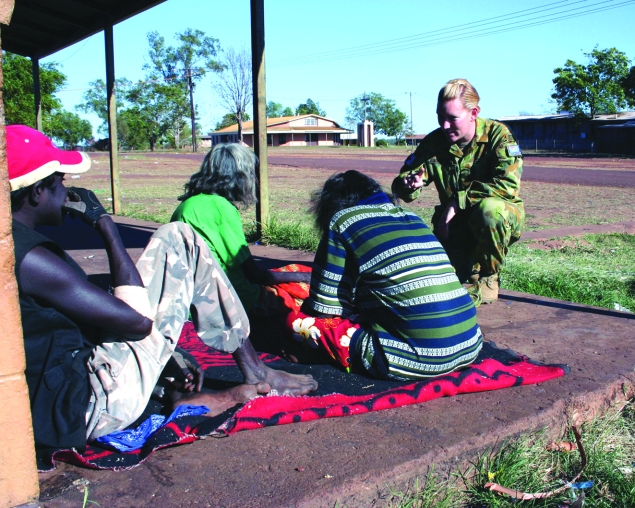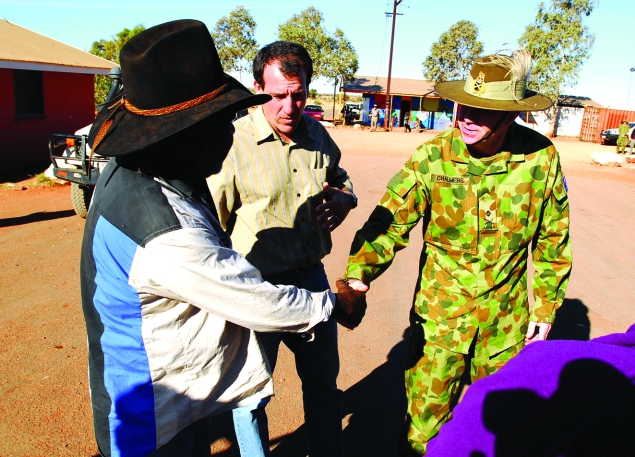Abstract
The vast disparities between the health of Australia’s indigenous Aboriginals and the rest of the population are disquieting in such an affluent country. Jonathan Dart reports on how the government aims to improve Aboriginal health by tackling the social problems undermining their communities.
David Wongway is an elder of the Imanpa council in the Aboriginal community of Mount Ebenezer in the Northern Territory. The 200-strong community has been here for longer than anyone can remember and lives a remote existence far from the trappings of urban life in cities like Melbourne and Sydney.
The nearest big town is Alice Springs, 200 kilometres to the north-east, and the next closest is a 10-hour drive to Adelaide, 1200 kilometres to the south. When a team of army medics arrived to perform mandatory health checks in July last year, Wongway was one of many in the community unsure of what was happening. “But they [were] good, they helped us,” he said.
For most Australians, the lives of desert Aboriginal tribes in central Australia are hard to comprehend. Today, 85% of Australians live within 50 kilometres of the coastline while the Northern Territory has a population of just over 200 000 people spread across an area of 1.34 million square kilometres with 104 distinct indigenous languages spoken.
But there is more than just geography and skin colour that sets Wongway and his kinsmen apart. The average Aboriginal household earns only about 55% of an average Australian family, US$ 316 a week compared with US$ 575. Aboriginal poverty is associated with social problems such as unemployment and high imprisonment rates.
It’s in this context that the health outcomes of the Aboriginal population lag behind the rest of Australia. Average indigenous life expectancy is about 60 years for men and 68 for women – an average 17 years lower than that of the total population, according to the Australian Bureau of Statistics.
Australia’s 517 200 Aboriginals make up 2.5% of the population and are the country’s most disadvantaged group. Their communities have higher infant mortality, and more drug abuse and alcoholism, than the rest of the population. They also suffer more from diseases associated with poor living conditions, such as scabies and pneumonia.
Australia’s indigenous people are three times more likely to contract diabetes and are almost twice as likely to suffer heart disease between the ages of 35 and 44 than the total population. Aboriginals also have to deal with problems long eradicated in Australia’s cities, such as trachoma. When the World Health Organization (WHO) launched a campaign in 1998 to eliminate trachoma globally by 2020, blinding trachoma still occurred in 54 countries. Australia was the only developed country on that list.
The poor health of indigenous communities has been likened – by policy-makers and commentators – to the problems of the developing world. There are few people who understand the problems facing such communities as well as Dr Paul Torzillo. For the past 25 years, he has been leaving his home in Sydney to fly to the Nganampa Health Council in central Australia – a service that operates nine clinics that treat 3000 people spread out across a vast area of 105 000 square kilometres.
Few Aboriginals are still living in the same makeshift camps and humpies – improvised shelters made out of bush materials – that they occupied when he first went there. But progress has been slow and Torzillo said this has been mirrored in the communities’ health. “There have been improvements in living conditions,” he said, “but the improvements haven’t reached the critical level where people can, for instance, wash reliably and frequently.”
Penetrating the heart of the country takes more than just a five-hour plane flight for people like Torzillo, it also takes vision. Two weeks before the federal election in November 2007, the Australian Medical Association declared indigenous Australians to be the “forgotten people” of the election. But while the election may not have catapulted indigenous health to the forefront of debate, it nonetheless revealed two very different visions from Australia’s two major political parties.
The first of those visions had begun to form more than a decade before under the conservative government of John Howard. In the 11-year period from 1996, the Howard administration not only expanded spending on indigenous-specific programmes by 42% – totalling US$ 3.07 billion in 2007–2008 – but it also sought to redefine the social contract under which resources were distributed. It put emphasis on mutual responsibility and performance indicators to ensure that money was not being wasted.
In 2004, the government signed a “shared responsibility agreement” with the Mulan Aboriginal community in the Kimberley region – a vast, sparsely populated area of desert and mountains in north-western Australia. The government imposed conditions but agreed to fund a petrol pump so long as the community met a series of personal hygiene standards, including children washing their faces twice a day. The move was applauded by some commentators, such as conservative Aboriginal intellectual Noel Pearson, but was publicly criticized by a group of doctors who complained about a lack of consultation and the lack of autonomy for indigenous communities.
The doctors’ criticism was only a blip on the edge of the radar but it was a sign of things to come. The most comprehensive – and controversial – policy was unveiled after the release in June 2007 of the report of the Board of Inquiry into the Protection of Aboriginal Children from Sexual Abuse. Of 45 communities surveyed, the report found 68 cases of offences involving juveniles such as the prostitution of a child for drugs.
In response, the government seized control of 60 Aboriginal communities in the Northern Territory in what the then prime minister John Howard described as a “national emergency”. Among measures implemented was the use of the army to conduct mandatory health checks for children aged under 16 and the banning of alcohol in some regions. Welfare payments were tied to standards set by the government – payments could be suspended, for instance, if a child failed to meet a school attendance quota.
While the measures won widespread support in the Australian community, including the then opposition Labor party, it also provoked criticism. For the National Aboriginal Community Controlled Health Organisation (NACCHO) – the national Aboriginal health body – the lack of consultation and cooperation in the intervention undermined indigenous communities’ trust in the health system. NACCHO’s executive officer, Dea Delany-Thiele, said there “are several barriers preventing indigenous people from accessing the health system, and mistrust and fear are high among them.”
Although per capita health sector spending is 18% higher for indigenous people, half of this is spent on hospital care. This is put down to a reluctance by Aboriginal people to visit doctors’ surgeries; as a result they turn up at emergency departments.
The need to foster confidence in the health-care system has long been promoted by WHO. A WHO health and human rights adviser, Helena Nygren-Krug, described participation as a human right: “People have a right to participate in making decisions about their health, about their development, about their future,” she said. “Whether that actually improves health outcomes, is something that isn’t necessarily the starting point.
“But we do think that there is evidence to show that if you involve communities in designing their own approaches to how they want to improve their health, you actually have more sustainable programmes and a much higher uptake. You will improve health outcomes in the long term.”
The second vision for indigenous Australia has begun to unfold under the Labor government, which was swept to power in November. Throughout the election, the policy differentials between the two main parties were not always clear. Apart from bipartisan support for the Northern Territory intervention – both parties fell well short of committing to the additional US$ 428 million a year that the Australian Medical Association said is needed to address indigenous primary health care issues.
But under Prime Minister Kevin Rudd, there has been a concerted effort to win the support of Aboriginals. On 13 February, in its first parliamentary sitting, the government delivered a historic apology to Aboriginal people for past injustices. The Labor government also committed to closing the 17-year gap in life expectancy between Aboriginal and other Australians within a generation and to halving Aboriginal infant mortality rates within a decade. The government formed what politicians refer to as a bipartisan “war cabinet” with the opposition to implement a national indigenous housing strategy to reduce overcrowding. Of the two and three-bedroom dwellings in Australia in which 10 or more people live, 80% are occupied by indigenous people.
Asked about the government’s priorities, indigenous affairs minister Jenny Macklin said that there will be little progress made by spending money on indigenous health without first addressing the chronic social problems that have been eating away at Aboriginal society. “Our priority is to close the gap,” she said. “We have to decide where we will put the necessary federal government money and we think the place has to be in addressing the terrible levels of disadvantage in housing, in health, in education, in making sure that people are participating in the economy.”
It’s a mission that will rely heavily on the support and confidence of people like David Wongway. Barely three months into the new administration, life goes on as usual at Mount Ebenezer, but there are small signs that change is ready to crack through the desert sands. “I think things will get better,” Wongway said. “People here, we’re looking forward.” ■
Army medic Christy Eglington consults with members of a community in Wadeye in the Northern Territory.
Australian Department of Defence
Major General David Chalmers, of the Inter-Agency Northern Territory Emergency Response Task Force, and Mal Brough, indigenous affairs minister, are greeted by David Wongway, a member of the Imanpa Local Community Council.
Australian Department of Defence




